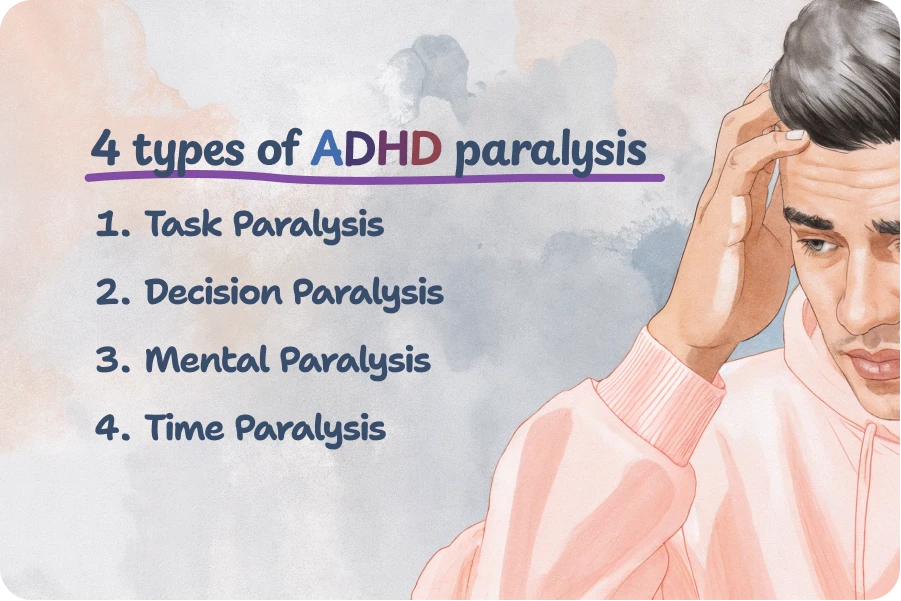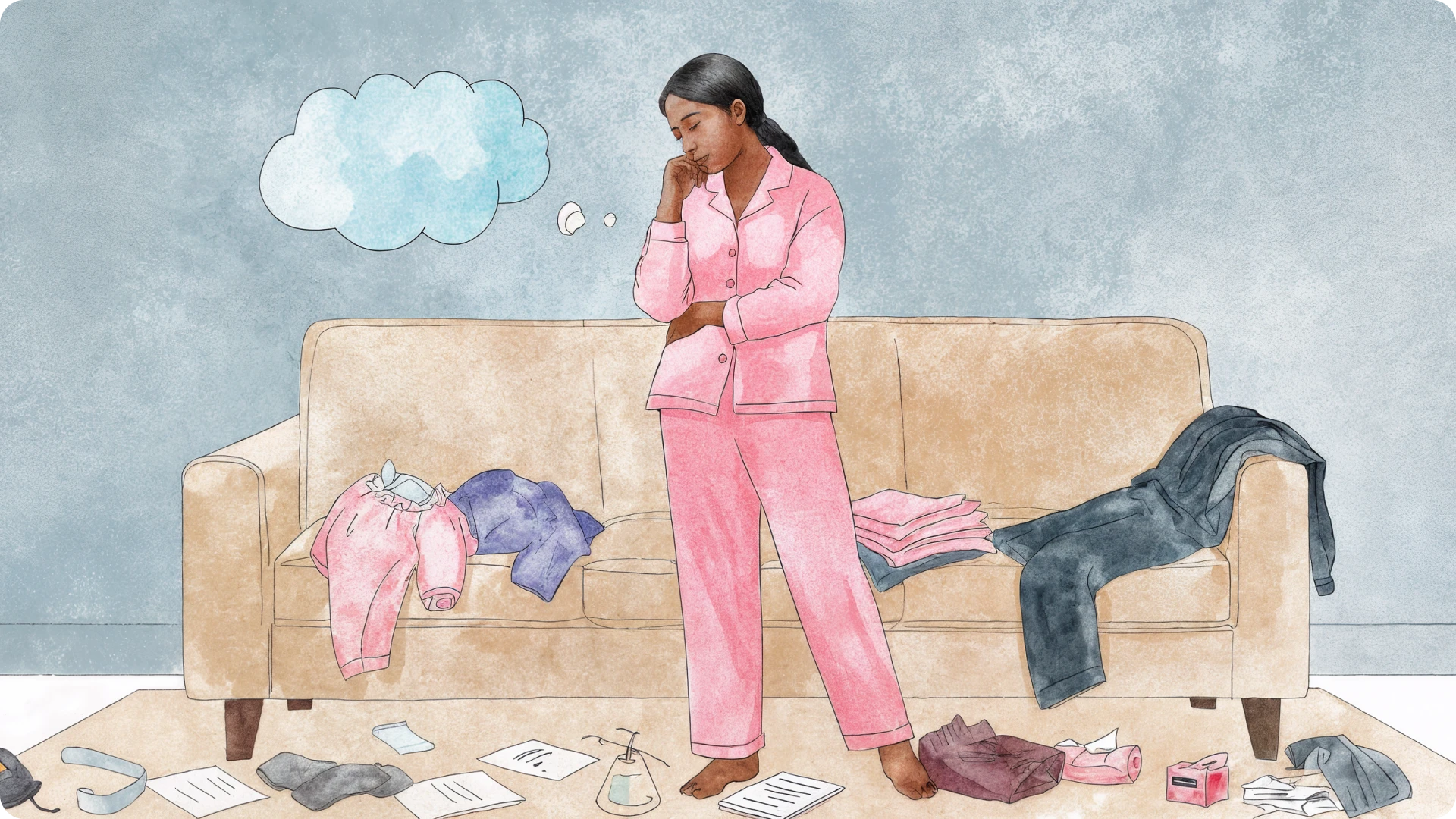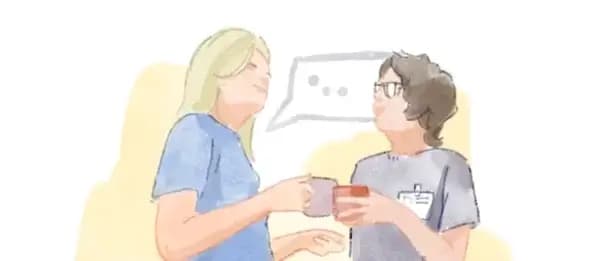Have you ever found yourself staring at the clock while knowing you need to do a million things but just couldn’t seem to get started? ADHD paralysis, the constant feeling of being too busy to do even the simplest things, can stop you from getting things done. But you can still get motivated and maintain focus again. This post will walk you through the steps to overcoming ADHD paralysis.
What is ADHD paralysis?
ADHD paralysis is a mental and emotional blockage marked by a strong feeling of being stuck, which is related to how brains with attention deficit hyperactivity disorder process information and stimuli. It comes in types of ADHD paralysis: task paralysis, mental paralysis, and ADHD choice paralysis.
The cause of this paralysis is rooted in the core symptoms of ADHD, which include inattention, hyperactivity, and impulsivity. ADHD paralysis symptoms can show up as a group of cognitive issues that make it hard to organize, plan, make decisions, keep track of time, and begin new tasks. Usually, you might feel unable (physically and emotionally) to do your duties, no matter how important they might be.
For example, you could be writing a client proposal, an email, or even something as simple as a grocery list when your train of thought abruptly stops and paralysis sets in, making you unable to do anything for that day or further ones.
ADHD paralysis is not a clinical diagnosis or official term used by healthcare professionals, but it is a common experience that people with neurodivergency may feel on occasion.
What’s more, this condition may cause stress, low self-esteem, a growing list of responsibilities and overall mental health struggles in people with ADHD. And because there are responsibilities and deadlines, it can alleviate anxiety and shame as well.
ADHD paralysis vs. executive dysfunction
Executive functions are a set of mental skills that assist you in accomplishing tasks. These include working memory, cognitive flexibility, and inhibitory control. Although executive functioning strategies can help with paralysis, focusing on the specific factors that cause paralysis in ADHD patients is more effective.
Are procrastination and ADHD paralysis the same?
Both procrastination and ADHD paralysis involve delaying and failing to complete tasks. They are, nevertheless, brought on by opposing causes. Procrastination is more commonly defined as a voluntary delay in completing tasks. It is, of course, influenced by a lack of motivation, a fear of failing, or a desire for perfection, and practically everyone can relate to it in some way.
Conversely, the neurological functioning of the ADHD brain causes more complex paralysis, which is rarely voluntary. [1] It can happen when someone is so overwhelmed by decisions, chores, or overwhelming feelings that they can’t put any mental power into something. The perceived difficulty of the task or the individual’s confidence in their ability to complete it is not always relevant to paralysis.
ADHD paralysis vs. depression
Both of these conditions are sometimes mistaken for being lazy. However, there are more distinct differences in how it feels on emotional, energy and motivational levels.
- Emotional Experience
ADHD paralysis is characterized by frustration and anxiety about being unable to begin tasks, whereas depression is defined by a deeper, more persistent sense of despair and sadness.
- Energy Levels
With ADHD paralysis, you may experience bursts of energy but have nowhere to direct them. Depression, on the other hand, is characterized by a persistent sense of fatigue and low energy.
- Motivation
People with ADHD paralysis want to do their work but can’t get started. People with depression, on the other hand, lose interest in their work completely.
ADHD paralysis symptoms
Symptoms of ADHD paralysis can include:
- Difficulty starting tasks
- Anxiety about deadlines but unable to start the task anyway
- Feeling overwhelmed by choices
- When you need to do something, you have brain fog
- Frequent procrastination
- Persistent shame of not being productive
- Mental exhaustion and mental fatigue
- Feeling powerless and lacking motivation
4 types of ADHD paralysis
There are several ways that adults with ADHD can feel paralyzed. Some people can move from one task to another without getting stuck in hyperfocus paralysis, which can make them forget about other things they need to do. Some people find it hard to decide what to do when they have a lot of options.
Let’s explore these examples of ADHD paralysis in more detail.
1. ADHD task paralysis
When faced with a lot of work, it is easy to become so consumed by the perceived size of the tasks at hand that the very idea of starting can be mentally taxing. It leads to inaction and ADHD task paralysis.
Picture yourself at the beginning of the day, with a lot of things vying for your attention. You want to start, but a crippling feeling of indecision sets in. Ultimately, it abandons you before you have even moved forward.
2. Decision Paralysis
For ADHDers, every choice means devoting some of their limited mental resources to that option. Faced with an array of options, even a simple decision like selecting a cereal can trigger a flood of overthinking, also known as ADHD choice paralysis and analysis paralysis.
In order to make the “right” choice, ADHDers can get stuck on the “what-ifs,” which makes it impossible to make a choice at all. People who have ADHD and trouble making choices can “fight” over things that most people would just see as normal in the grocery aisle, for example.
3. Mental Paralysis
When you have ADHD mental paralysis, your mind becomes cloudy and you are unable to plan, think, or even finish the most basic tasks. There are many different ways that mental paralysis can appear, from executive dysfunction, which makes it challenging to start or finish a task, to a final stop as ADHD burnout, which happens after a period of intense focus.
4. ADHD Time Paralysis
ADHD time paralysis is a frustrating type of paralysis that makes even the simplest task seem monumental. You know you need to get moving, but you just can’t. It is similar to being trapped in mental quicksand.

ADHD paralysis test
See if you have ADHD paralysis by asking yourself these 10 thought-provoking questions.
1. Do simple tasks often make you feel overwhelmed?
2. Do you often find yourself procrastinating?
3. Are you struggling with poor time management?
4: Do you often feel mentally exhausted?
5. Do you find it difficult to get started on tasks?
6. Is your workspace often cluttered?
7. Do you experience deadline anxiety but choose to do nothing anyway?
Answering “yes” to at least four questions could suggest that you may have symptoms of ADHD paralysis.
Causes of ADHD paralysis
ADHD paralysis occurs with a combination of genetic, environmental, and neurological factors. Additional environmental and psychological factors, like anxiety, fear of failure, and perfectionism can also influence its development and persistence.
Psychological Factors of ADHD paralysis
- Deficits in Executive Function. An individual with ADHD symptoms may experience problems with their executive functions. These are the mental abilities that assist us in completing tasks. [2] This impairment can cause paralysis. For example, they may struggle to control their impulses, stay organized, and keep track of time, making it difficult to create and stick to plans when these mental processes slow down.
- Emotional Dysregulation. Researchers have found that people with ADHD can also suffer from mental health conditions like anxiety and depression. [3] It could make them even more open to or sensitive to the stress of the things they need to learn or do. It’s also harder to get things done when someone’s mood changes because they may feel too overwhelmed by fears of failing or not being good enough.
- Decision-Making Challenges. Adults with ADHD may find it too hard to make choices, which can lead to mental overload and a lack of action. [4]
Triggers of ADHD paralysis
No matter what the psychological cause of paralysis is, the environment has a lot to do with both making it worse and causing it.
- Overstimulation: ADHD overstimulation can “shut down” the ability to concentrate and make it nearly impossible to start or continue with a task.
- Lack of Structure. Paralysis can get worse for adults who do not have a set schedule or clear instructions on what they need to do.
- Avoidance Behaviors. For people with ADHD, procrastination is an automatic way of dealing with the stress and uncertainty that tasks cause. [5] This avoidance behavior can develop into paralysis very quickly.
How to get out of ADHD paralysis
Here are more actionable tips to manage ADHD paralysis.
Start by breaking down tasks
If you find a large task frustrating, break it up into smaller goals and cross them off as you complete them. This task decomposition is among the best methods for managing paralysis that can boost your confidence by breaking down difficult tasks into manageable chunks and rewarding you with a series of small victories.
To accomplish this:
- Divide all tasks into tiny steps, so tiny that you no longer feel afraid of them
- Handle them gradually, step by step
- If you need to stop, you can continue later, immediately, without feeling overwhelmed
Eat the frog
This method requires you to do the most unpleasant task first thing in the morning in order to avoid overwhelm and self-doubt and remain motivated later. This method increases productivity, according to a study published in the Journal of Experimental Social Psychology.
Try time management techniques
For people with ADHD, traditional time management techniques aren’t always effective. Alternatively, take into account:
- Time blocking is a method that sets aside particular time slots to concentrate on individual tasks.
- Turning off notifications and limiting other distractions
- Schedule extra minutes between tasks; this “buffer zone” will allow you to relax, change your focus from one task to another, and lessen the stress that comes with always being in a hurry.
- Use apps like Trello for visual task management or tools like the Pomodoro Technique to work in concentrated intervals with scheduled breaks.
- Plan your workload ahead
Use checklists and calendars to follow consistent routines
To reduce procrastination and ADHD paralysis, it can be helpful to create morning, evening, or work routines. For example, your morning checklist can look like the following:
- Wake up and make your bed
- Drink a glass of water
- Take vitamins
- Shower and get dressed
- Eat breakfast
- Check your calendar once a day
- Pack your bag
- Set reminders for important appointments
The Breeze app for ADHD paralysis management
You can also try Breeze, which allows you to manage the symptoms of ADHD more easily. Self-discovery tests let you find out more about the daily challenges you may face and provide tailored insights to become more productive. A mood tracker lets you notice your worries, while customizable routines are perfect for getting more organized.
Follow your whims
Going with the flow and doing what you want is fine if you have the time. Getting things you want done isn’t always more important than creating and following a list.
Mindfulness and self-care
- Practicing mindfulness and meditation regularly may transform how you interact with the world. It also increases self-awareness and control.
- Journal your thoughts and worries to reduce emotional clutter
- Along with self-care habits like working out and getting enough sleep, these can help lessen the emotional effects of ADHD paralysis.
When to seek professional help
If you continue to have an ADHD shutdown response when performing important tasks or making decisions, you should consider seeking assistance from a mental health specialist.
Psychotherapy is an important part of ADHD treatment. Cognitive-behavioral therapy (CBT) and dialectical-behavioral therapy (DBT) can assist you in better managing your ADHD symptoms, developing coping strategies to avoid distraction, planning daily activities, and overcoming low self-esteem.
Expert Insight
If you’re struggling with ADHD paralysis, you might feel a combination of shame, guilt, or anxiety about what you’re experiencing – remember to treat yourself with compassion. A win is a win, and each small step forward is better than none at all; break each task down into smaller parts until the next part feels doable, then focus only on that part. You’ll often find that completing this task builds the momentum to keep going. For professional advice about ADHD, please reach out to a medical or psychological professional.
Katherine Pocock
Mental health professional
Medications
To balance brain chemistry, a doctor may prescribe either stimulant or non-stimulant medications. The first option is usually chosen, but if the side effects are unbearable, they may choose non-stimulants.
According to studies, ADHD brains “use up” dopamine much faster than neurotypical brains. [6] As a result, healthcare professionals may prescribe antidepressants to some people to alleviate ADHD symptoms as well as paralysis.
Sources:
- Norman LJ, Carlisi CO, Christakou A, Murphy CM, Chantiluke K, Giampietro V, Simmons A, Brammer M, Mataix-Cols D, Rubia K. Frontostriatal Dysfunction During Decision Making in Attention-Deficit/Hyperactivity Disorder and Obsessive-Compulsive Disorder. Biol Psychiatry Cogn Neurosci Neuroimaging. 2018 Aug
- Rabinovici GD, Stephens ML, Possin KL. Executive dysfunction. Continuum (Minneap Minn). 2015 Jun;21(3 Behavioral Neurology and Neuropsychiatry)
- Katzman MA, Bilkey TS, Chokka PR, Fallu A, Klassen LJ. Adult ADHD and comorbid disorders: clinical implications of a dimensional approach. BMC Psychiatry. 2017
- Mäntylä T, Still J, Gullberg S, Del Missier F. Decision making in adults with ADHD. J Atten Disord. 2012
- Niermann HC, Scheres A. The relation between procrastination and symptoms of attention-deficit hyperactivity disorder (ADHD) in undergraduate students. Int J Methods Psychiatr Res. 2014
- Volkow ND, Wang G, Kollins SH, et al. Evaluating Dopamine Reward Pathway in ADHD: Clinical Implications. JAMA. 2009
Disclaimer
This article is for general informative and self-discovery purposes only. It should not replace expert guidance from professionals.
Any action you take in response to the information in this article, whether directly or indirectly, is solely your responsibility and is done at your own risk. Breeze content team and its mental health experts disclaim any liability, loss, or risk, personal, professional, or otherwise, which may result from the use and/or application of any content.
Always consult your doctor or other certified health practitioner with any medical questions or concerns
Breeze articles exclusively cite trusted sources, such as academic research institutions and medical associations, including research and studies from PubMed, ResearchGate, or similar databases. Examine our subject-matter editors and editorial process to see how we verify facts and maintain the accuracy, reliability, and trustworthiness of our material.
Was this article helpful?








